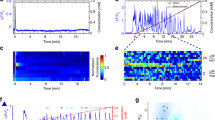Summary
A new method is described for studying the behavioral responses of nematodes to controlled chemical stimulation. The worm is held by the tail with a suction pipet. Behavior is recorded by an array of light sensors connected to a multichannel recorder. Several types of behavior can be detected in addition to the normal backward propagating waves of about 2 Hz that propel untethered worms forward. The most dramatic of these is the reversal bout, consisting of forward propagating waves of about 0.7 Hz, that propel untethered worms backward. The latter waves are easily distinguished from the former by the large amplitude motion caused by the fact that they contain a sharper bend at the tail. This technique was used to demonstrate that a purely temporal change in chemical stimulation can cause a large change in the probability of occurrrence of a reversal bout. These altered probabilities adapt back to the basal level in about one minute. Increased probabilities adapt faster than decreased. Stronger stimulation causes slower adaptation. Since the reversal bout is associated with changes in direction of locomotion, these observations suggest that klinokinesis with adaptation plays a role in the movement of nematodes in chemical gradients.
Similar content being viewed by others
References
Berg, H.C., Tedesco, P.M.: Transient response to chemotactic stimuli inEscherichia coli. Proc. Natl. Acad. Sci. USA72, 3235–3239 (1975)
Boyd, I.A., Roberts, T.D.B.: Propioceptive discharges from stretch-receptors in the knee-joint of the cat. J. Physiol. (London)122, 38–58 (1953)
Brenner, S.: The genetics ofCaenorhabditis elegans. Genetics77, 71–94 (1974)
Croll, N.A.: Components and patterns in the behavior of the nernatodeCaenorhabditis elegans. J. Zool. (London)176, 159–176 (1975)
Croll, N.A.: WhenCaenorhabditis elegans (Nematoda: Rhabditidae) bumps into a bead. Can. J. Zool.54, 566–570 (1976)
Croll, N.A.: Sensory mechanisms in nematodes. In: Annu. Rev. Phytopathol.15, 75–89 (1977)
Culotti, J.G., Russell, R.L.: Osmotic avoidance defective mutants of the nematodeCaenorhabditis elegans. Genetics90, 243–256 (1978)
Dusenbery, D.B.: Analysis of chemotaxis in the nematodeCaenorhabditis elegans by countercurrent separation. J. Exp. Zool.188, 41–47 (1974)
Dusenbery, D.B.: The avoidance of D-tryptophan by the nematodeCaenorhabditis elegans. J. Exp. Zool.193, 413–418 (1975)
Dusenbery, D.B.: Attraction of the nematodeCaenorhabditis elegans to pyridine. Comp. Biochem. Physiol. [C]53, 1–2 (1976)
Edgar, R.S., Wood, W.B.: The nematodeCaenorhabditis elegans, A new organism for intensive biological study. Science198, 1285–1286 (1977)
Fraenkel, G.S., Gunn, D.L.: The orientation of animals. New York: Dover Publications 1961
Fuortes, M.G.F., Poggio, G.F.: Transient responses to sudden illumination in cells of the eye of Limulus. J. Gen. Physiol.46, 436–452 (1963)
Green, C.D.: Simulation of nematode attraction to a point in a flat field. Behavior61, 130–146 (1977)
Hedgecock, E.M., Russell, R.L.: Normal and mutant thermotaxis in the nematodeCaenorhabditis elegans. Proc. Natl. Acad. Sci. USA72, 4061–4065 (1975)
Rubik, B.A., Koshland, D.E. Jr.: Potentiation, desensitization, and inversion of response in bacterial sensing of chemical stimuli. Proc. Natl. Acad. Sci. USA75, 2820–2824 (1978)
Ward, S.: Chemotaxis by the nematodeCaenorhabditis elegans: Identification of attractants and analysis of the response by use of mutants. Proc. Natl. Acad. Sci. USA70, 817–821 (1973)
Ward, S., Thomson, N., White, J.G., Brenner, S.: Electron microscopical reconstruction of the anterior sensory anatomy of the nematodeCaenorhabditis elegans. J. Comp. Neurol.160, 313–338 (1975)
Author information
Authors and Affiliations
Additional information
I would like to thank Deborah Higgins for technical assistance. This work was supported by Grant RR 07024q3 awarded by the Biomedical Research Support Grant Program, Division of Research Resources, National Institutes of Health and by the National Science Foundation under Grant GB-43561.
Rights and permissions
About this article
Cite this article
Dusenbery, D.B. Responses of the nematodeCaenorhabditis elegans to controlled chemical stimulation. J. Comp. Physiol. 136, 327–331 (1980). https://doi.org/10.1007/BF00657352
Accepted:
Issue Date:
DOI: https://doi.org/10.1007/BF00657352




